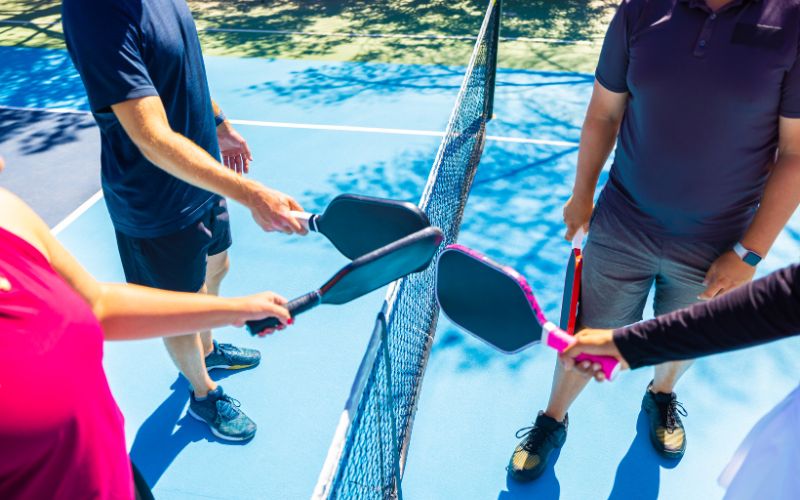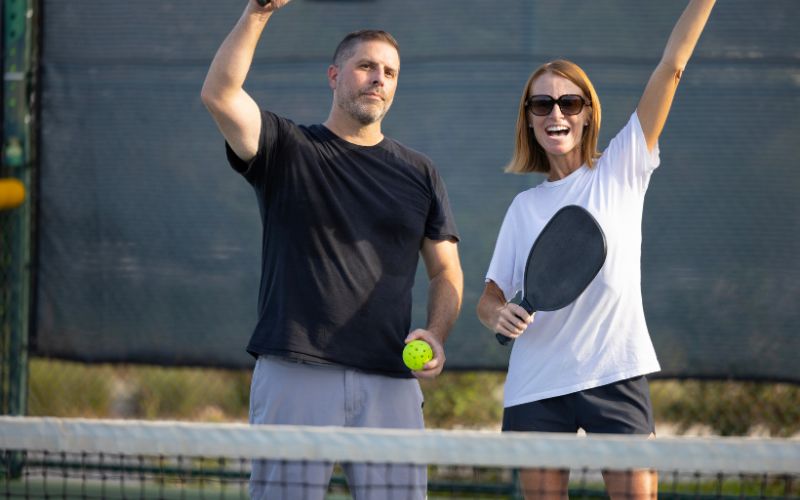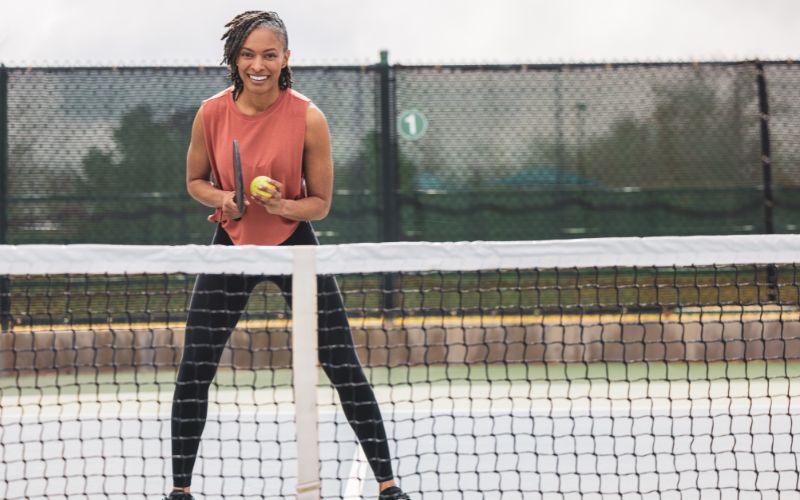Pickleball is a fast-paced and exciting racquet sport that combines elements of tennis, badminton, and table tennis. One of the fundamental aspects of playing pickleball effectively is knowing how to hold the pickleball paddle correctly. Your grip on the paddle head can significantly impact your control, power, and overall performance on the court. In this comprehensive guide, we’ll explore different ways to hold pickleball paddle, the pickleball paddle grips, the right techniques for holding the paddle, and provide expert tips to help you enhance your game.
Understanding Pickleball Paddle Grips
The Continental Pickleball Grip
The continental grip is one of the most commonly used grips in pickleball. To achieve this grip:
- Hold the paddle handle as if you were shaking hands with it.
- Place the base knuckle of your index finger on the third bevel (0/6–10 o’clock position) of the paddle.
Pro Tip: Maintain a relaxed grip with this style for better control and flexibility.
The Western Grip
The western pickleball grip is another popular grip style, primarily used by players with a tennis background. Here’s how to do it:
- Hold the paddle handle as if you were holding a frying pan.
- Position your hand so that the base knuckle of your index finger is on the second level (0/8–12 o’clock position).
Pro Tip: The western grip offers more power for your shots.
The Eastern Pickleball Grip
The eastern grip is a variation of the continental grip and is well-suited for players who want a balance of control and power:
- Hold the paddle handle as if you were shaking hands with it.
- Place the base knuckle of your index finger on the second bevel (8 o’clock position) of the paddle.
Pro Tip: This grip works well for players who prefer a versatile approach.
Pickleball Paddle Grip Techniques
Grip Pressure
Regardless of the grip style you choose, maintaining the right grip pressure is crucial. Avoid gripping the paddle too tightly, as it can hinder your wrist movement and control. Instead, hold the paddle firmly but with a relaxed grip to allow for quick adjustments during play.
Neutral Grip
A neutral grip is when your hand is in a natural, comfortable position on the paddle handle. This grip allows for easy transition between different shots and provides flexibility during quick exchanges at the kitchen line.
Paddle Handle and Paddle Face
Understanding the anatomy of your pickleball paddle is essential for grip and control:
Paddle Handle: This is the part you grip. The handle’s circumference can vary between paddles, so choose one that feels comfortable in your hand.
Paddle Face: The paddle face is the flat surface that contacts the ball. It’s essential to keep this part facing your opponent when hitting shots.
The Right Grip for the Right Shot
Different grip styles can be advantageous depending on the situation:
Forehand Side: The eastern grip and neutral grip are suitable for forehand shots, providing control and versatility.
Backhand Side: The western grip can offer more power for backhand shots.
Benefits of a Good Grip
A good grip is crucial in sports like pickleball as it can significantly impact your performance on the court. Here are the benefits of having a good grip on your pickleball paddle:
- More Control: A proper grip allows you to have better control over your shots. You can precisely place the ball where you want it on the court, making it more challenging for your opponents to return effectively.
- Improved Accuracy: With a secure and consistent grip, you can develop a more accurate and consistent stroke technique. This leads to fewer unforced errors and a higher success rate for your shots.
- Enhanced Feel: A good grip provides better feel and feedback from the paddle. You can sense the ball’s contact with the paddle face more effectively, allowing you to adjust your shots with greater precision.
- Better Spin Control: Controlling the paddle’s angle with a strong grip allows you to impart spin on the ball more effectively. Adding spin can make your shots more unpredictable and challenging for your opponents to handle.
- Reduced Vibration: A proper grip helps dampen the vibrations that travel from the paddle to your hand upon impact with the ball. This reduces the risk of discomfort, fatigue, or injury during prolonged play.
- Efficient Energy Transfer: When you grip the paddle correctly, you can transfer your energy more efficiently into your shots. This results in more powerful and controlled strokes.
- Quick Adjustment: With a good grip, you can quickly adjust your hand position on the paddle handle to adapt to different shots and playing situations. This flexibility is essential for reacting to fast-paced rallies.
- Consistency: A consistent grip allows you to maintain the same playing style and technique throughout a match. This consistency is valuable for building a reliable and effective game strategy.
- Reduced Risk of Injury: An improper grip can strain your wrist, forearm, or shoulder over time. A good grip minimizes the risk of injury by promoting a more natural and ergonomic wrist position.
- Confidence: Knowing that you have a secure grip on your paddle can boost your confidence on the court. This confidence can lead to better decision-making and performance under pressure.
- Versatility: A skilled player with a good grip can adapt to various playing situations and opponents. Whether you need finesse for soft shots or power for smashes, a solid grip allows you to switch between styles with ease.
Changing Grips
Advanced players often change their grip during a game to adapt to different situations. Learning to switch between grips seamlessly can elevate your pickleball skills.
Pickleball Tips and Techniques
Now that you have a solid foundation on pickleball paddle grips and techniques, practice is key to mastery. Experiment with different grips to find the one that suits your playing style best. As you gain experience, you’ll discover the nuances of grip and how it can impact your overall performance on the pickleball court.
Pickleball Tips for Beginners
- Master the Basics: Start with the fundamentals, including the proper grip, basic strokes, and court positioning.
- Stay at the Kitchen Line: In pickleball, the kitchen line (non-volley zone) is critical. Avoid stepping into it unless necessary, as volleying from here can give you a strong advantage.
- Communicate with Your Partner: If you’re playing doubles, communication is key. Coordinate with your partner for better court coverage and strategy.
- Practice Dinking: Learn the art of dinking, which involves hitting soft shots over the net. This technique can help control the game and set up opportunities for smashes.
- Move Your Feet: Stay light on your feet and be ready to move quickly. Good footwork allows you to react to shots effectively.
- Watch the Ball: Keep your eyes on the ball at all times. This may seem obvious, but it’s crucial for timing your shots and positioning.
- Control Your Serve: Develop a consistent and controlled serve. Aim for a deep serve that lands in your opponent’s backcourt to start the point with an advantage.
- Practice Your Returns: Work on your return to serve to start rallies with an advantage. Try to keep the ball low over the net and away from your opponents’ strong positions.
Intermediate Pickleball Techniques
- Master the Third Shot Drop: The third shot drop is a soft shot that you play after the serve and return. It should land softly in the kitchen, making it challenging for your opponents to attack.
- Add Spin to Your Shots: Incorporate spin into your shots, such as topspin and backspin, to create different ball trajectories and make it harder for your opponents to predict the ball’s path.
- Vary Your Shots: Keep your opponents guessing by mixing up your shots. Use lobs, drives, and drops strategically to disrupt their rhythm.
- Anticipate and Position: Work on your court awareness and positioning. Try to anticipate your opponents’ shots and move into the right position to make winning shots.
- Use the Lob Effectively: A well-executed lob can be a powerful offensive tool. Practice lobs to catch your opponents off guard and create opportunities for winners.
Advanced Pickleball Strategies:
Learn Defensive Skills: Develop your defensive skills, including blocking hard shots and returning smashes effectively.
Master the Volley: Work on your volleying skills to become more aggressive at the net. A strong volley game can put pressure on your opponents.
Fake Shots: Add deception to your game by occasionally faking a shot to force your opponents out of position.
Target Weaknesses: Identify your opponents’ weaknesses and exploit them. If they have a weaker backhand, focus your shots there.
Play Mind Games: Mental toughness is vital in pickleball. Stay focused, remain calm under pressure, and use psychological tactics to gain an advantage.
Adapt to Your Opponents: Be adaptable and adjust your strategy based on your opponents’ playing style and strengths.
Continuous Improvement: Never stop learning and improving. Attend clinics, watch instructional videos, and play with more experienced players to refine your skills.
In pickleball, mastering the art of holding your paddle is a fundamental step towards improving your game. Understanding the different grip styles, knowing when to use them, and maintaining the right grip pressure can make a significant difference in your performance on the court. Practice and experimentation will help you find the perfect pickleball grips for your playing style, ensuring that you’re always getting a handle on pickleball.
Frequently Asked Questions
Can I use a tennis grip for pickleball?
Yes, the western grip is similar to a tennis grip and can be effective in pickleball.
Do I need to change my grip for every shot?
No, you can use a neutral grip for quick exchanges and transition to specific grips for power shots when needed.
What is the most common grip among pickleball players?
The continental grip is the most widely used grip in pickleball.






